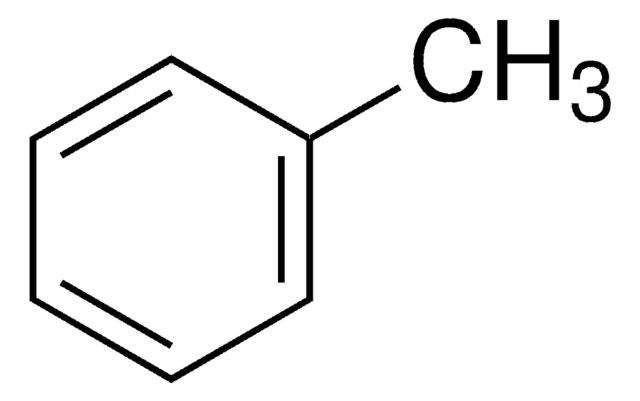32249
Toluene
puriss. p.a., ACS reagent, reag. ISO, reag. Ph. Eur., ≥99.7% (GC)
About This Item
26 mmHg ( 25 °C)
Recommended Products
grade
ACS reagent
puriss. p.a.
Quality Level
Agency
USP/NF
reag. ISO
reag. Ph. Eur.
vapor density
3.2 (vs air)
vapor pressure
22 mmHg ( 20 °C)
26 mmHg ( 25 °C)
Assay
≥99.7% (GC)
form
liquid
autoignition temp.
997 °F
expl. lim.
7 %
technique(s)
microbiological culture: suitable
impurities
≤0.0001% thiophene
≤0.001% free acid (as HCl)
≤0.001% free alkali (as NaOH)
≤0.001% non-volatile matter
≤0.003% S-compounds (as S)
≤0.02% water (Karl Fischer)
color
APHA: ≤10
refractive index
n/D 1.496 (lit.)
n20/D 1.496-1.498
bp
110-111 °C (lit.)
mp
-93 °C (lit.)
density
0.865 g/mL at 25 °C (lit.)
cation traces
Al: ≤0.5 ppm
Ba: ≤0.1 ppm
Bi: ≤0.1 ppm
Ca: ≤0.5 ppm
Cd: ≤0.05 ppm
Co: ≤0.02 ppm
Cr: ≤0.02 ppm
Cu: ≤0.02 ppm
Fe: ≤0.1 ppm
K: ≤0.5 ppm
Li: ≤0.1 ppm
Mg: ≤0.1 ppm
Mn: ≤0.02 ppm
Mo: ≤0.1 ppm
Na: ≤0.5 ppm
Ni: ≤0.02 ppm
Pb: ≤0.1 ppm
Sr: ≤0.1 ppm
Zn: ≤0.1 ppm
SMILES string
Cc1ccccc1
InChI
1S/C7H8/c1-7-5-3-2-4-6-7/h2-6H,1H3
InChI key
YXFVVABEGXRONW-UHFFFAOYSA-N
Looking for similar products? Visit Product Comparison Guide
General description
Application
Other Notes
The article number 32249-4X2.5L-M will be discontinued. Please order the single bottle 32249-2.5L-M which is physically identical with the same exact specifications.
The article number 32249-6X1L will be discontinued. Please order the single bottle 32249-1L which is physically identical with the same exact specifications.
The article number 32249-6X1L-M will be discontinued. Please order the single bottle 32249-1L-M which is physically identical with the same exact specifications.
Signal Word
Danger
Hazard Statements
Precautionary Statements
Hazard Classifications
Aquatic Chronic 3 - Asp. Tox. 1 - Flam. Liq. 2 - Repr. 2 - Skin Irrit. 2 - STOT RE 2 Inhalation - STOT SE 3
Target Organs
Central nervous system
Storage Class Code
3 - Flammable liquids
WGK
WGK 3
Flash Point(F)
39.9 °F - closed cup
Flash Point(C)
4.4 °C - closed cup
Regulatory Information
Choose from one of the most recent versions:
Already Own This Product?
Find documentation for the products that you have recently purchased in the Document Library.
Our team of scientists has experience in all areas of research including Life Science, Material Science, Chemical Synthesis, Chromatography, Analytical and many others.
Contact Technical Service


